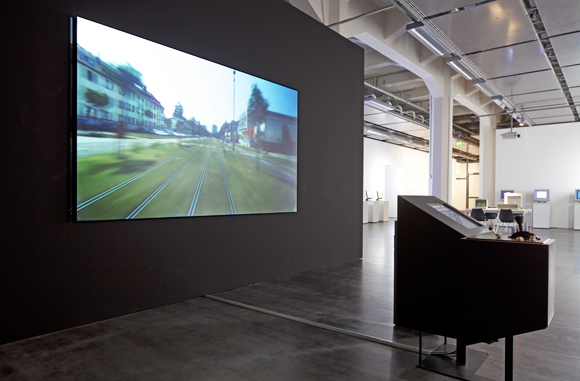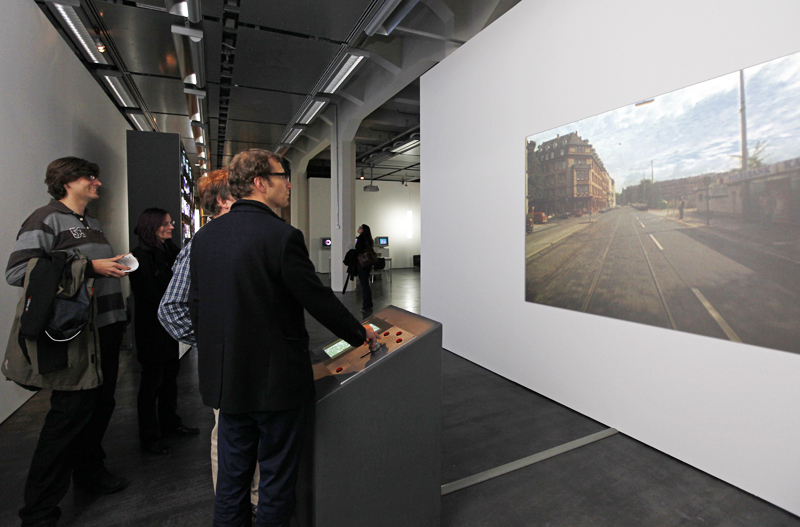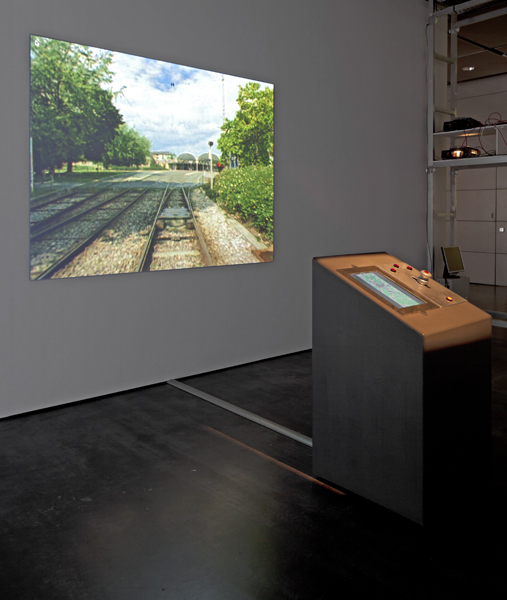|
Karlsruhe Moviemap, 1991 and 2009
Michael Naimark

By means of a driver’s instrument panel mounted on a plinth, the viewer can experience a simulated journey in the extensive network of the KVV (Karlsruher Verkehrsverbund), Karlsruhe’s regional transport network. Here, movement in space is limited to forwards and backwards until you reach a crossroads where there is the additional possibility of turning left or right. The height of the projection is determined so as to give the viewer the feeling that he is present in the represented space. However, the speed of the vehicle can be accelerated to speeds far in excess of the normal speed of the actual tram. Karlsruhe Moviemap is shown here in two versions. Unlike the original 1991 version, the 2009 version is stereoscopic – using 3D-glasses, the projected street views create a stronger impression of spatial depth.
In developing a series of Moviemaps, of which the Karlsruhe Moviemap is one, Michael Naimark wanted to create a new form of cinematographic experience for the viewer – a non-linear perception of actually-filmed images. However, the viewer’s capacity for action is here limited. This virtual navigation, according to Naimark, is not a form of interactivity, instead the viewer traces a journey selected and created by the artist. The rail network of the KVV had been one specified element in a commission to create an installation exploring the history of the local urban landscape. After participating in the creation of Aspen Moviemap at Massachusetts Institute of Technology in the late 1970s, Naimark worked on a number of Moviemaps in various cities. According to Naimark, his particular interest lay in the creation of a sense of “presence” in the observer. However, he also laid considerable importance on the filming of real places – not the creation of virtual worlds – and on co-operation with local people. For his project Be Here Now (2000), Naimark displayed images from Jerusalem, Dubrovnik, Timbuktu and Angkor as panorama projections and thus helped the audience to experience a strongly “immersive” view of these places. Naimark studied cybernetic systems and since the 1970s has been active in the areas of cinematography, interactive systems and immersive projections.
Conservation measures
Between 2006 and 2008, the 1991 installation Karlsruhe Moviemap was thoroughly reworked by the ZKM and Michael Naimark. Subsequently in 2009, after agreement with the artist, the ZKM produced a new version of the work on its own initiative. While this is a new incarnation of the concept of Karlsruhe Moviemap, it differs radically from the first. This case study strives to document the changes made to the 1991 version and to document any later adaptations. In addition, the case study offers a rare opportunity to compare the results of fundamentally different conservation strategies: hardware preservation / migration on the one hand and reintepretation on the other”.
The original 1991 version uses a laserdisc for data storage, an optical storage medium which – unlike DVD – only permits analog recording and replay. A back-projection box enabled the representation of the tram ride, while a steering device specially designed for the exhibition was built into a stand at waist height. All components other than the image-reproducing technology were contained within this stand, including the laserdisc player and the steering computer. Naimark used a computer (Apple IIsi) as an intermediate element, in order to, for example use the laserdisc player to reproduce the route selected by the viewer at the control panel.
In order to increase reliability and build a more dependable, robust system, between 2006 and 2008 several changes were made to the 1991 version. Delicate components were replaced or sometimes simply removed without replacement. The monitor and the Apple IIsi computer were exchanged. The laserdisc originally used was digitized during this process, rendering the laserdisc player redundant. The digital material was now reproduced in the form of a video-file (in QuickTime container format, see also Samuel Rousseau, Untitled) directly fed through an Apple Power Mac G5 (replacing the Apple IIsi).
In 2009, the ZKM produced a fully new and entirely separate installation, based on the original concept of Karlsruhe Moviemap. Once again, the rail network of the KVV was recorded. Whilst in 1991, 16mm film cameras were used, in 2009 the images were recorded and processed with the help of digital photography. The viewer could now undertake a stereoscopic journey through the KVV rail network, moving from the center of Karlsruhe high into the Black Forest. The equipment used to present this reinterpretation included two video-projectors, a silver screen, 3D-glasses, software newly developed at the ZKM (“Panorama Display Software”) and a reconceived instrument panel with a tram’s original steering panel and a touchscreen.
The two key issues of this case study were the retrospective documentation of the manifold changes to the version of 1991 and the building of the new 2009 version. In the case of this work, the strategy of hardware preservation was particularly valuable, because the first version encompassed recordings of the city of Karlsruhe in 1991, lending the work a documentary character that could not be retained in the reinterpreted version of 2009.


Photos: ONUK
|